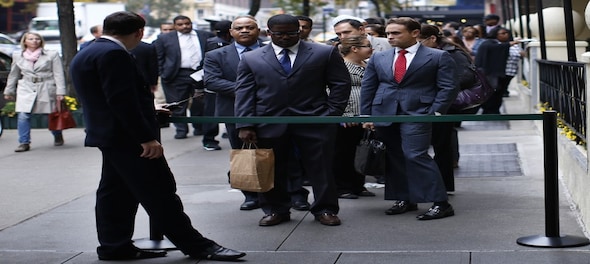
US job growth accelerated in April while wage gains increased solidly, pointing to sustained labor market strength that could compel the Federal Reserve to keep interest rates higher for longer as it fights to bring inflation under control.
The Labor Department's closely watched employment report on Friday also showed the unemployment rate falling back to more than a 50-year low of 3.4 percent. Though data for February and March were revised sharply lower, the labor market is slowing only marginally.
The US central bank raised its benchmark overnight interest rate by another 25 basis points to the 5.00-5.25 percent range on Wednesday and signaled it may pause its fastest monetary policy tightening campaign since the 1980s, though it kept a hawkish bias.
"The Fed may have been wrong to hint they were pausing their rate hikes, as there is absolutely zero evidence that the bank crisis is doing the work of monetary policy tightening that two or three more rate hikes could do," said Christopher Rupkey, chief economist at FWDBONDS in New York.
Nonfarm payrolls rose by 253,000 jobs last month, but the economy created 149,000 fewer jobs in February and March than previously reported. Job growth has averaged 290,000 jobs per month over the prior six months.
The economy needs to create 70,000-100,000 jobs each month to keep up with growth in the working-age population.
The service-providing sector accounted for most of the job gains in April, with professional and business services adding 43,000 positions. But temporary help services employment, seen as a harbinger for future hiring, dropped by just over 23,000 positions and is down by 174,000 since its peak in March 2022.
Healthcare payrolls increased by 40,000 in April. Employment in the leisure and hospitality industry rose by 31,000 jobs, mostly concentrated at restaurants and bars. Hiring in the sector, which has been the main job growth driver, is slowing.
Employment in the industry remains 402,000 jobs below its pre-pandemic level. Financial activities payrolls rose by 23,000, as did the government jobs category. Government employment remains 301,000 positions below its pre-pandemic level. Manufacturing and construction payrolls rebounded after declining in March.
Also Read: Vice-President Dhankhar arrives in London, meets King Charles III ahead of his coronation
The Fed has hiked its policy rate by 500 basis points since March 2022.
US stocks opened higher. The dollar rose against a basket of currencies. US Treasury prices fell.
SOLID WAGE GAINS
Some economists, however, believe that the labor market is overstating the health of the economy, pointing to the divergence between consumer spending and job gains as well as a continued decline in worker productivity.
Consumer spending stalled in February and March. Productivity has declined on a year-over-year basis for five straight quarters, the longest such stretch since the government started tracking the series in 1948.
"This is very strange in a growth year, and I think it says that businesses are hoarding workers," said Milton Ezrati, chief economist at Vested in New York. "Managers remember what happened in 2021, and they don't want to be caught short."
With the risks of a recession mounting because of the punitive borrowing costs and tighter credit conditions that have coincided with financial market stress, the hiring landscape could change quickly. For now, the general consensus is that the economy will continue to create jobs at least until the fourth quarter.
Average hourly earnings gained 0.5 percent last month after advancing 0.3 percent in March. Wages increased 4.4 percent on a year-on-year basis in April after climbing 4.3 percent in March.
Other measures such as the Employment Cost Index and the Atlanta Fed's wage tracker also show momentum. Wage growth remains too strong to be consistent with the Fed's 2 percent inflation target.
Details of the household survey from which the unemployment rate is calculated were largely muted. Household employment slowed, while the labor force fell modestly. That led to the jobless rate falling to 3.4 percent from 3.5 percent in March.
The labor force participation rate, or the proportion of working-age Americans who have a job or are looking for one, was unchanged at 62.6 percent. With the share of those aged 25 to 54 at pre-pandemic levels, there is limited scope for further gains in the participation rate.
First Published: May 5, 2023 11:44 PM IST
Check out our in-depth Market Coverage, Business News & get real-time Stock Market Updates on CNBC-TV18. Also, Watch our channels CNBC-TV18, CNBC Awaaz and CNBC Bajar Live on-the-go!


Prajwal Revanna's father in custody for alleged kidnapping and sexual abuse
May 4, 2024 7:53 PM
Delhi, Indore, Surat and Banswara — why these are the most challenging domains for Congress internally
May 4, 2024 1:53 PM
Congress nominee from Puri Lok Sabha seat withdraws, citing no funds from party
May 4, 2024 12:00 PM
Lok Sabha Polls '24 | Rahul Gandhi in Rae Bareli, why not Amethi
May 4, 2024 9:43 AM

